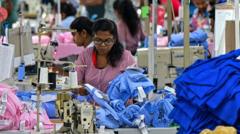In a region already rife with economic insecurity, garment workers in Asia are grappling with anxieties as the looming deadline for a crucial U.S. trade agreement approaches. Cambodian and Sri Lankan factories, which supply a significant portion of their apparel products to American brands, face a potential struggle for survival due to heavy tariffs recently announced by the U.S. government.
On July 9, U.S. President Donald Trump notified several countries of impending tariffs set to take effect on August 1, following a 90-day window during which nations could negotiate better trade terms. Countries like Cambodia and Sri Lanka received stark notifications of tariff rates—36% and 30% respectively. These new duties continue to stoke fears among millions of garment workers, already living precariously, about job security and the welfare of their families.
Women like Nao Soklin, a factory worker in Cambodia, express desperation over the impact such tariffs may have. “Can you imagine what will happen if [we] lose our jobs? I'm so worried, especially for my kids. They need food,” she remarked, highlighting the grim reality faced by many in similar positions. The garment industry in Cambodia represents not just economic activity but sustains the livelihoods of over 900,000 workers, contributing significantly to the nation’s export economy with over $3 billion in apparel sales to the U.S. last year.
In Sri Lanka, where about 350,000 workers are directly involved in the garment sector, the uncertainty is palpable as well. The U.S. market provided $1.9 billion to Sri Lanka's garment exports in the past year, marking it as the nation’s third-largest source of foreign income. Yohan Lawrence, a representative from the Joint Apparel Association Forum, voiced concerns that if the proposed 30% tariff is finalized, it may put Sri Lanka at a disadvantage compared to competitors like Vietnam, which has negotiated more favorable terms.
Efforts to negotiate reduced tariffs continue in both countries. Sri Lankan officials remain optimistic, having secured a 14 percentage point concession during previous negotiations. Meanwhile, Cambodia's Deputy Prime Minister Sun Chanthol insists on striving for a zero tariff, while acknowledging existing challenges in the negotiations.
The rationale presented by Trump for the tariffs centers on creating a more reciprocal trading relationship, claiming that the current dynamics leave the U.S. at a disadvantage. However, this approach has drawn criticism from experts, including Professor Mark Anner, who argue that such tariffs ignore the advantages of lower-cost apparel for American consumers and substantial profits for U.S. corporations.
In addition to economic implications, social dynamics also emerge as women comprise about 70% of the garment workforce in the region. The potential for increased unemployment poses a grave risk, particularly for families that depend on these jobs for basic necessities.
Both Cambodia and Sri Lanka find themselves in a difficult position, navigating international political tensions while trying to preserve jobs for vulnerable populations. As changes unfold, many workers, like An Sopheak from Cambodia, express a dire hope that the tariffs might be lifted. “We pray every day that President Trump will lift the tariff,” she shared, underlining the desperate hope for relief from impending economic difficulties.




















